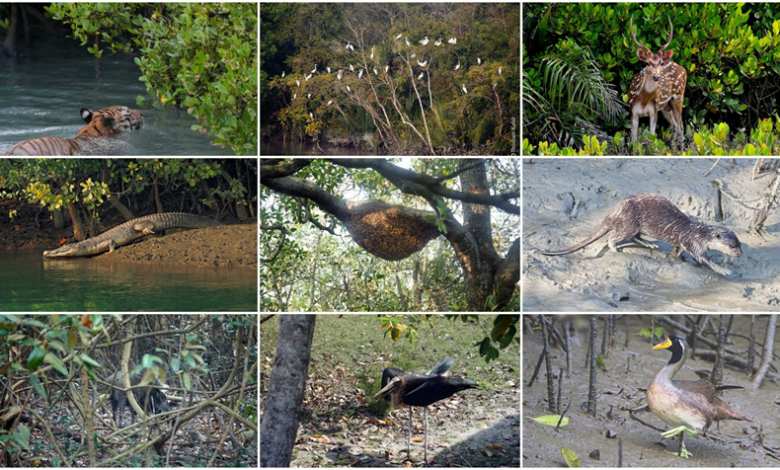Top 10 Rare Animals to Spot in the Sundarbans
News Mania Desk / Piyal Chatterjee / 10th January 2025

The Sundarbans, a UNESCO World Heritage Site and the world’s largest mangrove forest, spans the delta of the Ganges, Brahmaputra, and Meghna rivers. Located primarily in Bangladesh and India, this unique ecosystem is not only famous for its lush greenery and intricate waterways but also for its incredible biodiversity. It is home to some of the rarest and most elusive animals on the planet. Here are the top 10 rare animals you might be lucky enough to spot in the Sundarbans:
- Royal Bengal Tiger
The Royal Bengal Tiger is the undisputed king of the Sundarbans. Known for their adaptability to the mangrove environment, these tigers are skilled swimmers and adept at navigating the dense forests. Unfortunately, their population is critically endangered due to habitat loss and poaching. Spotting a tiger in the Sundarbans is a once-in-a-lifetime experience, though it requires patience and luck as they are elusive and primarily nocturnal.
- Saltwater Crocodile
The saltwater crocodile is the largest living reptile and a dominant predator in the Sundarbans. These crocodiles inhabit the estuarine waters and mangrove swamps, making them a key species in maintaining the ecological balance. With their immense size and powerful jaws, they are both fascinating and formidable.
- Irrawaddy Dolphin
This rare species of dolphin, with its unique rounded head and short beak, is found in the brackish waters of the Sundarbans. Irrawaddy dolphins are shy and usually travel in small groups, making them challenging to spot. Their conservation status is vulnerable due to pollution and accidental entanglement in fishing nets.
- Fishing Cat
The fishing cat, a medium-sized wild feline, is well-adapted to the aquatic environment of the Sundarbans. It is an excellent swimmer and primarily feeds on fish, crabs, and other small aquatic creatures. Listed as vulnerable, these nocturnal hunters are rarely seen during the day.
- Ganges River Dolphin
Also known as the “Susu,” the Ganges River Dolphin is a freshwater species found in the rivers of the Sundarbans. Blind in the traditional sense, they use echolocation to navigate and hunt in the murky waters. These dolphins are endangered due to pollution, dam construction, and overfishing.
- Sundarbans Mangrove Pit Viper
This venomous snake is one of the lesser-known inhabitants of the Sundarbans. The Sundarbans mangrove pit viper is well-camouflaged, blending seamlessly with the mangrove trees. Although not aggressive, they are venomous and should be admired from a safe distance.
- King Cobra
The king cobra, the world’s longest venomous snake, is another rare species that calls the Sundarbans home. Revered and feared in equal measure, these majestic reptiles are known for their intelligence and unique hooded appearance. They primarily feed on other snakes and occasionally rodents.
- Lesser Adjutant Stork
This large, striking bird is a rare sight in the Sundarbans. Known for its bald head and neck, the lesser adjutant stork is a scavenger, feeding on fish, amphibians, and carrion. While they are not strictly aquatic, their preference for wetlands and mangroves makes the Sundarbans an ideal habitat.
- Olive Ridley Sea Turtle
The Olive Ridley sea turtle, the smallest of all marine turtles, is another rare inhabitant of the Sundarbans. These turtles are known for their synchronized nesting, called arribadas, though this behavior is less frequent in the Sundarbans compared to other regions.
- Sundarbans Honey Bee
Though not an animal in the traditional sense, the Sundarbans honey bee plays a crucial role in the ecosystem and the livelihood of local communities. These bees produce the famous Sundarbans honey, a prized natural resource. While not rare globally, the unique ecosystem of the Sundarbans makes their honey collection a risky yet rewarding endeavor for local honey gatherers.
Conservation Challenges and Efforts
The Sundarbans faces numerous threats, including rising sea levels, deforestation, and poaching. Conservation efforts are vital to protect this unique habitat and its rare inhabitants. Governments and organizations are working to promote sustainable tourism, enforce anti-poaching measures, and engage local communities in conservation initiatives.
Final Thoughts
Exploring the Sundarbans offers an unparalleled opportunity to witness some of nature’s rarest creatures in their natural habitat. However, spotting these elusive animals requires respect for their environment and adherence to sustainable tourism practices. By protecting the Sundarbans and its biodiversity, we ensure that future generations can experience its wonders and learn from its ecological significance.






